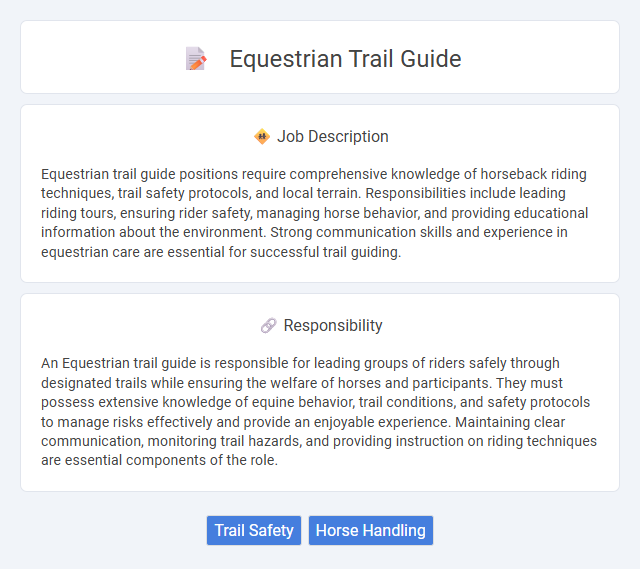
Equestrian trail guide positions require comprehensive knowledge of horseback riding techniques, trail safety protocols, and local terrain. Responsibilities include leading riding tours, ensuring rider safety, managing horse behavior, and providing educational information about the environment. Strong communication skills and experience in equestrian care are essential for successful trail guiding.
People with good physical stamina and a love for outdoor activities will likely be well-suited for an equestrian trail guide job, given the demands of prolonged riding and navigating varied terrain. Those who possess strong communication skills and a patient demeanor may have a higher probability of succeeding, as guiding diverse groups safely is essential. Conversely, individuals with severe allergies to animals or limited experience with horses might find the role less suitable for their abilities.
Qualification
Equestrian trail guide positions require comprehensive knowledge of horse behavior, trail safety protocols, and local terrain navigation. Candidates must possess certification in first aid and equine handling, along with strong communication skills for guiding diverse groups safely. Previous experience in trail riding and the ability to manage emergency situations enhance job qualifications significantly.
Responsibility
An Equestrian trail guide is responsible for leading groups of riders safely through designated trails while ensuring the welfare of horses and participants. They must possess extensive knowledge of equine behavior, trail conditions, and safety protocols to manage risks effectively and provide an enjoyable experience. Maintaining clear communication, monitoring trail hazards, and providing instruction on riding techniques are essential components of the role.
Benefit
Equestrian trail guide jobs likely offer significant benefits such as opportunities for outdoor work and physical activity, which can promote health and well-being. There is probably a chance to develop strong horsemanship skills and deepen knowledge of local wildlife and terrain. This role may provide meaningful interactions with clients, enhancing communication and leadership abilities.
Challenge
Working as an equestrian trail guide likely presents significant challenges due to unpredictable weather conditions and varying levels of rider experience. Navigating rugged terrain requires strong problem-solving skills and physical stamina to ensure both horse and rider safety. The ability to adapt quickly to emergencies or unexpected trail obstacles may be crucial for success in this role.
Career Advancement
Equestrian trail guide careers offer opportunities for advancement through specialized training in horse care, trail safety, and customer service. Professionals can progress to roles such as lead guide, stable manager, or equestrian program coordinator by gaining experience and certifications. Developing skills in wilderness navigation and emergency response further enhances prospects for leadership positions within equestrian tourism companies.
Key Terms
Trail Safety
Equestrian trail guide roles prioritize comprehensive trail safety to ensure rider protection and animal well-being during outdoor excursions. They conduct thorough trail inspections, monitor weather conditions, and implement safety protocols to prevent accidents and injuries. Mastery in first aid, wildlife awareness, and emergency response is essential for managing risks inherent in equestrian trail environments.
Horse Handling
Proficiency in horse handling is essential for an equestrian trail guide to ensure rider safety and horse well-being during excursions. Skills include leading, grooming, saddling, and managing horses in varied terrain while recognizing signs of distress or fatigue. Knowledge of equine behavior enables instant response to rider and horse needs, enhancing trail experience quality and trust.
 kuljobs.com
kuljobs.com